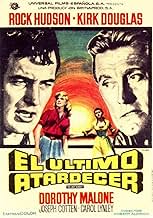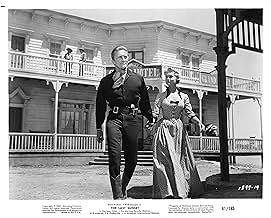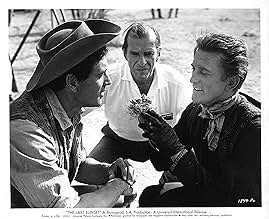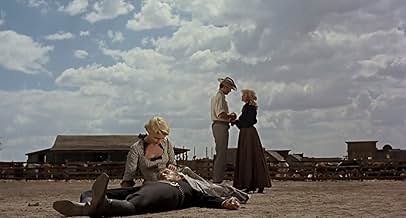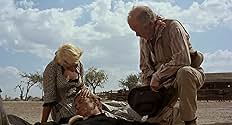Füge eine Handlung in deiner Sprache hinzuAt a Mexican ranch, fugitive O'Malley and pursuing Sheriff Stribling agree to help rancher Breckenridge drive his herd into Texas where Stribling could legally arrest O'Malley, but Breckenri... Alles lesenAt a Mexican ranch, fugitive O'Malley and pursuing Sheriff Stribling agree to help rancher Breckenridge drive his herd into Texas where Stribling could legally arrest O'Malley, but Breckenridge's wife complicates things.At a Mexican ranch, fugitive O'Malley and pursuing Sheriff Stribling agree to help rancher Breckenridge drive his herd into Texas where Stribling could legally arrest O'Malley, but Breckenridge's wife complicates things.
- Regie
- Drehbuch
- Hauptbesetzung
- Auszeichnungen
- 1 Nominierung insgesamt
- Julesburg Kid
- (as Rad Fulton)
- Singing ranch hand
- (Nicht genannt)
- Bartender saloon
- (Nicht genannt)
- Man at Cock Fight
- (Nicht genannt)
- Man in saloon
- (Nicht genannt)
- Man at Saloon
- (Nicht genannt)
- Man in saloon
- (Nicht genannt)
Empfohlene Bewertungen
Although a bit too plodding in places, there are enough surprises throughout the film to make this a less predictable film than many of it's contemporaries. It all builds towards a surprising and welcome ending.
Kirk Douglas is at his captivating best as the anti-hero. He easily outshines Rock Hudson but to be fair his character is far more interesting. Good support is provided by Dorothy Malone and I thought Carol Lynley did a good job as the daughter.
With a more energetic script this really could have been a great western and it's a shame that despite the great final scenes, it is merely above average. Saying that it's still worth watching for fans of the western genre.
Made in 1961, this film is a fine example of an art form that was dying - the 1950's western. John Wayne carried on making them for a few years more (and arguably up to "The Shootist"), but by 1964, three years after this picture, the Spaghetti Western had arrived, and the genre was transformed for ever. The 1950's in Europe and America was an era of social stability - some would say stagnation - and the western reflected the values of the rigid, disciplined society which produced it. Plots did not vary much, innovation not being something that audiences craved, and storylines turned on predictable devices like cattle stampedes, indians on the skyline, fast draws and a man doing what a man's got to do. This film happens to contain all of these stock ingredients.
Man's desire for woman is a theme running through the story in deftly-worked permutations. Dalton Trumbo's better than average script has older men lusting after younger women, men harbouring fantasies of lost love, bad guys leering at decent matrons, and much more. Belle is made a chattle in her husband's droving contract, and receives a new proposal of marriage under the flying buttresses of a Mexican church. In keeping with the film's symbolic structure, she reserves her response until the Rio Grande has been crossed (Mexico seems to preserve the Americans in aspic, preventing them from advancing their plans, just as the church architecture encloses Belle and her lover).
"The Last Sunset" is several cuts above the average western. Its plot situation, the pursuit of one man by another and the involvement of a ranching family, is neatly established at the outset with minimal dialogue. The immediate sexual electricity between O'Malley and Belle engages the viewer, and O'Malley's little comic touches convey his charm and 'open him up' for the viewer. Belle's inner conflict is quickly made plain for us, and O'Malley's behaviour (graciously allowing her to leave the barn) is psychologically interesting, suggesting that he is certain of her. We want to know more about these characters. Much is achieved with the merest of glances, as when Breckenridge tells O'Malley "everything that's mine is yours", and O'Malley darts a look at Belle, or the glance thrown by Stribling when he realises why O'Malley is taking the appalling risk of returning to Texas.
Expert editing by Michael Luciano enhances the effectiveness of the movie considerably. When O'Malley teaches the Julesburg Kid a lesson on horseback, elliptical cutting skilfully evokes the Kid's sense of dizziness and confusion. At the final shoot-out, the accelerating rapidity of the cuts increases the tension brilliantly. There is one small lapse at the start of the cattle drive - the pick-up shot of O'Malley fording the river (overcast sky) does not match the master shot (bright sunshine).
O'Malley's song, "Pretty Girl In The Yellow Dress", runs through the film as a motif. It is a central symbol, because O'Malley's idealistic and doomed vision of Belle is transferred to Missy when she dons the dress - "a new smell to follow".
Admirable though it is, the film does have some weak points. Would Breckenridge REALLY accept O'Malley's second precondition? Would the wily O'Malley REALLY shoot the indian so rashly? The grassy bank on which O'Malley and Missy recline is patently a studio fabrication, bearing no resemblance to the parched earth of the location shots. Stribling's final comment on the derringer is clumsy overkill. We all got the point.
Good use is made of locations, especially old Spanish architecture like the crumbling aqueduct. The brick arches seem to be enveloping the Americans, just as their lives are stalled by being here in Mexico. Attractively-shot silhouettes adorn the dust-storm sequence, particularly during the quicksand episode. Once back in Texas, O'Malley is emblematically shut in by corral fences, a man left with nowhere to go. The film's great punchline, delivered by Belle on the verandah, is truly shocking.
Kirk Douglas and Rock Hudson, O'Malley and Stribling respectively, appear above the title (Douglas's own production company, named after his mother, financed the picture). Douglas is appealing and charismatic in one of his many 'generous-hearted bad guy' roles. Hudson is perfectly adequate in the straight-down-the-line part of Stribling, and looks terrific. The character of Belle, with her internal contradictions and the aura of having been buffeted by life, calls for an actress with both beauty and intelligence. Dorothy Malone is ideal in the role. Carol Lynley does very well as Missy, making a great transition from gawky kid to radiant woman. If Joseph Cotten fails to shine, it must be said that the part of Breckenridge is a dreary one. Neville Brand and Jack Elam turn in stock performances: as jobbing bad guys throughout the 1950's and early 60's, they must hardly ever have needed to shave.
Verdict - Interesting western with powerful denouement.
Brendan O'Malley (Douglas) is on the run and drifts into Mexico where he arrives at the home of old flame Belle Breckenridge (Malone). She resides with her drunkard husband John (Cotton) and her daughter Melissa, they are in preparation for a cattle drive to Texas. Hot on O'Malley's heels is lawman Dana Stribling (Hudson) who has a very personal reason for getting him back for justice to be served. Making an uneasy agreement, both men join the Breckenridge's on the drive. As they near Texas the tensions start to mount, not least because Stribling is starting to court Belle and O'Malley is increasingly drawn by her daughter Missy.
Lyrical, contemplative and evocative, three words you wouldn't readily associate with the director of Ulzana's Raid, The Longest Yard and The Dirty Dozen. Yet all three words are very fitting for this underseen Robert Aldrich movie. Although containing many of the basic elements that made up the American Western film's of the 50s, The Last Sunset has a very intriguing screenplay by Trumbo from which to flourish. The story is crammed full of sexual neurosis, yearnings, regret, hate, revenge and forbidden love. If that all sounds very "Greek Tragedy" then that's probably about right, as is the film being likened to a Western done by Douglas Sirk. It is melodramatic, but it does have moments of levity and up tempo action sequences, too. It's a very rounded picture, with very well formed characters, characters very well brought to life by the mostly on form cast. All played out amongst some gorgeous scenic panorama's that Aldrich and Laszlo have managed to make seem as poetic observers to the unfolding drama.
Some of it's odd, and the film is far from flawless (Cotten is poor, Elam & Brand underused), but the little irks are easily forgiven when judging the film as a whole. Lyrical, contemplative and evocative: indeed. 8/10
Wusstest du schon
- WissenswertesThis movie had a major influence on Sergio Leone, who worked with director Robert Aldrich on Sodom and Gomorrah (1962).
- PatzerWhen the Yaqui Indians turn up the second time, as the first Yaqui rider pulls his horse up, arrows can be seen falling from his quiver onto the the ground to his right (screen left).
- Zitate
Belle Breckenridge: To me, it always seems like it's the women who keep on living. Men kill or get killed and women bury them. We're professional survivors.
- VerbindungenFeatured in Rock Hudson's Home Movies - Demontage einer Kinolüge (1992)
- SoundtracksPretty Little Girl In The Yellow Dress
Music - Dimitri Tiomkin
Lyric - Ned Washington
Performed by Kirk Douglas (uncredited)
Top-Auswahl
- How long is The Last Sunset?Powered by Alexa
Details
Box Office
- Budget
- 3.500.000 $ (geschätzt)
- Laufzeit1 Stunde 52 Minuten
- Seitenverhältnis
- 1.85 : 1
Zu dieser Seite beitragen




